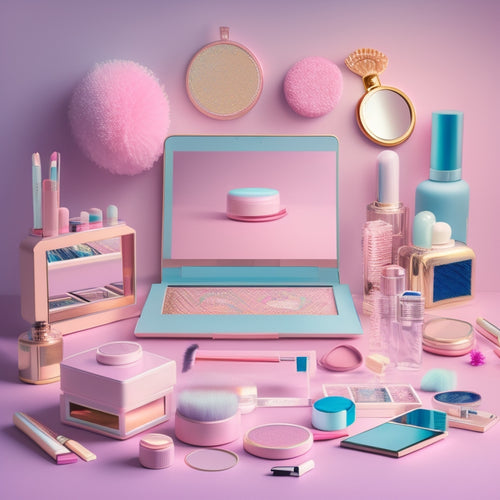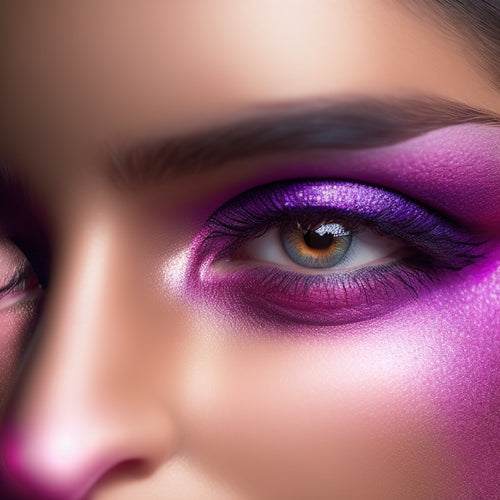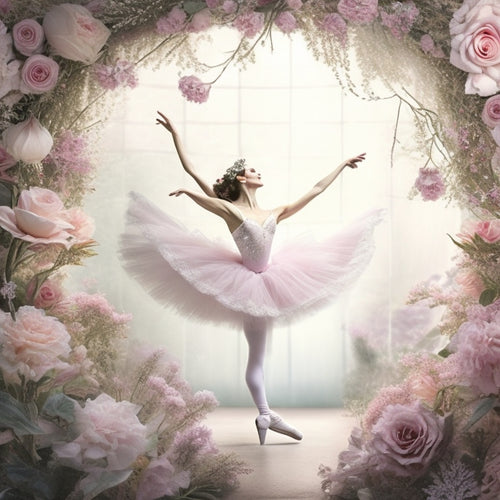
Why Perfect Dance Makeup Eludes Even the Pros
Share
You've likely struggled to achieve perfect dance makeup, despite your expertise, due to various challenges. Unrealistic client expectations can pressure you to deliver transformative results, while limited rehearsal time forces you to prioritize critical aspects of makeup design. Inadequate makeup training and subpar products can also sabotage your efforts. Moreover, flawed skin preparation and unforeseen stage lighting issues can compromise the final look. To overcome these obstacles, it's essential to understand the intricacies of dance makeup. By grasping the underlying factors, you'll be closer to mastering the craft, and discovering the secrets to achieving flawless, stage-ready looks.
Key Takeaways
• Unrealistic client expectations and pressure to deliver transformative results can lead to disappointing dance makeup outcomes.
• Inadequate makeup training and inconsistent application techniques hinder the achievement of perfect dance makeup.
• Limited rehearsal time and inefficient time management can compromise makeup preparation and overall quality.
• Subpar products and inadequate product research can sabotage dance makeup results, emphasizing the importance of high-quality products.
• Failure to consider skin tone, undertones, and stage lighting conditions can result in unflattering shadows and an unpolished appearance.
Unrealistic Expectations From Clients
When working with clients, you'll often encounter unrealistic expectations about the transformative power of dance makeup, with some assuming a single application can completely alter their physical appearance. This pressure to deliver an unrealistic ideal can be overwhelming, especially when clients bring in images of unreal beauty standards, expecting you to replicate them. Setting realistic expectations and educating clients on what dance makeup can and can't achieve is crucial.
Idealized looks often stem from fantasy makeup seen in media, creating unattainable beauty standards. You must manage client pressure by explaining the limitations of dance makeup and the importance of enhancing their natural features rather than trying to drastically change their appearance. By doing so, you can create a more collaborative and realistic approach to achieving their desired look.
Limited Time for Rehearsals
You're often left with limited time for rehearsals, which can be a significant challenge in perfecting the dance makeup look, especially when working with complex or intricate designs. This time constraint can lead to a Rehearsal Rush, where every minute counts, and even the smallest mistake can be costly.
When working under a Time Crunch, it's important to prioritize and focus on the most critical aspects of the makeup design. This might mean sacrificing some details or simplifying the design to make sure you can complete the look within the allotted time.
To make the most of your limited rehearsal time, it's vital to have a clear plan and a thorough understanding of the makeup design. Break down the look into smaller, manageable tasks, and allocate specific times for each step. This will help you stay focused and avoid wasting precious time.
Insufficient Makeup Training
Lacking sufficient makeup training can severely hinder your ability to perfect the dance makeup look, leaving you struggling to execute even the simplest designs. You may have a clear vision of the artistic expression you want to convey, but without the necessary skills, your makeup mastery will always fall short.
Insufficient training can lead to:
- Inconsistent application techniques, resulting in uneven changes and harsh lines
- Inadequate understanding of skin types, leading to poor product choices and unhappy dancers
- Limited knowledge of color theory, making it difficult to select harmonious shades
- Inability to adapt to different skin tones, textures, and facial structures
- Lack of confidence in your abilities, causing hesitation and uncertainty during application
Without proper training, you'll struggle to bring your artistic vision to life.
It's crucial to invest time in learning the fundamentals of makeup artistry to make sure you have the skills to support your creative expression. By doing so, you'll reveal the secrets to achieving flawless, show-stopping dance makeup that elevates your performances and leaves a lasting impression on your audience.
Poor Quality Products Used
Subpar products in your makeup kit can sabotage even the most meticulous dance makeup design, causing frustrating flaws and a less-than-polished finish. You may have invested hours perfecting your technique, but if you're using low-quality products, your hard work will be in vain.
To avoid this, it's important to conduct thorough product research, exploring different brands and reading reviews from fellow dancers and makeup artists. Develop your own brand preferences, identifying which products deliver consistent results and which ones fall short.
Don't be swayed by flashy packaging or false promises – instead, focus on the ingredients, texture, and performance of each product. By doing your due diligence, you'll build a makeup kit that's tailored to your specific needs, ensuring your dance makeup looks flawless and professional.
Inadequate Skin Preparation Routine
A flawed skin preparation routine can compromise the integrity of your dance makeup, making it difficult to achieve a smooth, even base that's essential for a polished performance. You may think you're doing everything right, but neglecting your skin prep can lead to uneven tone, clogged pores, and an overall lackluster look.
To get it right, remember:
-
Moisturizing routine: Don't skip this important step! A consistent moisturizing routine helps regulate your skin's pH levels, allowing your makeup to adhere smoothly.
-
Exfoliation techniques: Regular exfoliation removes dead skin cells, unclogs pores, and ensures a smooth canvas for your makeup. Choose a method that suits your skin type.
-
Skin typing: Understanding your skin type (normal, dry, oily, combination) helps you select products tailored to your needs, ensuring a flawless base.
-
Product layering: Learn to layer your products strategically, allowing each layer to absorb fully before adding the next. This prevents clogged pores and guarantees a seamless finish.
-
Hydration: Drink plenty of water to keep your skin hydrated from the inside out, giving your makeup a healthy, radiant glow.
Last-Minute Changes in Choreography
You've rehearsed your routine countless times, but last-minute changes in choreography can still throw you off, forcing you to adjust your dance makeup on the fly. Effective choreographer communication is key to minimizing these disruptions.
Establish open lines of communication with your choreographer to make sure you're both on the same page. This will help you anticipate and adapt to any changes, making adjustments to your makeup accordingly.
Adaptation strategies are also vital in these situations. Focus on versatility and flexibility in your makeup design, allowing for quick adjustments as needed. Consider using products that can be easily blended or layered to accommodate changes in lighting or costume.
Prioritize simplicity and time-efficiency in your makeup application, ensuring you can make adjustments swiftly without compromising the overall look. By staying communicative and adaptable, you'll be better equipped to handle last-minute choreography changes, making sure your dance makeup remains flawless and camera-ready.
Unforeseen Stage Lighting Issues
When you step onto the stage, you'll quickly realize that the lighting design can be unforgiving, accentuating every detail of your makeup. Harsh lighting realities will test the durability of your look, and unflattering shadows will appear where you least expect them.
As you prepare to perform, it's crucial to anticipate these challenges and adjust your makeup strategy accordingly.
Harsh Lighting Realities
As you step onto the stage, the unforgiving glare of the stage lights can suddenly render your meticulously applied dance makeup almost invisible. The challenging lighting realities can be intimidating, and even the most skilled makeup artists can struggle to achieve a flawless look under these conditions.
When it comes to stage lighting, color temperature plays an important role in how your makeup appears. Warm white lights (2800K-3000K) can create an orange or yellow hue, while cool white lights (5000K-6500K) can produce a blueish tone. This can greatly impact how your makeup looks, especially if you're using products with warm or cool undertones.
Additionally, light absorption is a significant aspect to take into account. Different materials absorb light in varying degrees, which can influence how your makeup appears under stage lights. For instance:
- Darker colors tend to absorb more light, making them appear less vibrant.
- Metallic or shimmering products can reflect light, creating an intense sparkle.
- Matte finishes can appear flat or dull under harsh lighting.
- Certain products may contain light-absorbing ingredients, affecting their overall appearance.
- Skin tone and undertones can influence how makeup looks under stage lighting.
Understanding these factors can help you adapt your makeup techniques to overcome the challenging lighting realities of the stage.
Unflattering Shadows Appear
Unforeseen stage lighting issues can create unflattering shadows that accentuate facial features, making your dance makeup look uneven and unpolished. You've spent hours perfecting your contouring technique, but harsh stage lights can undo all your hard work.
Facial contours that looked defined and enhanced in the dressing room can suddenly appear uneven or distorted under the glare of the stage lights. This is where Shadow Mapping comes in – an essential step in anticipating how light will interact with your makeup. By mapping out the areas where shadows are likely to fall, you can strategically apply concealer or highlighter to create a more balanced, polished look.
Don't let unflattering shadows ruin your dance makeup. Take control by understanding how light will interact with your features and plan your makeup accordingly. With practice and patience, you can master the art of Shadow Mapping and make sure your dance makeup looks flawless under any lighting conditions.
Frequently Asked Questions
How Do I Choose the Right Makeup Artist for My Dance Performance?
Imagine stepping onto the stage, spotlight shining bright, your makeup flawless. To find the perfect artist, you'll review portfolios, scrutinizing attention to detail, and assess artist chemistry, ensuring a harmonious collaboration that brings your vision to life.
Can I Use Everyday Makeup Products for a Dance Performance?
You can use everyday makeup products for a dance performance, but beware: foundation formulas may not withstand sweat and intense lighting, and limited color options might not provide the desired dramatic effect.
What's the Ideal Time to Do a Makeup Trial Before the Show?
"When scheduling a makeup trial, you should aim to do it 2-3 weeks before the show, like Emma, who nailed her look for the ballet performance after a trial session 17 days prior, ensuring a seamless Makeup Timeline and Trial Scheduling."
Are There Specific Makeup Techniques for Different Dance Styles?
"You'll want to master specific techniques for each dance style; for Ballet, emphasize subtle nuances with soft focus and delicate shading, while for HipHop, amplify drama with bold colors and sharp definition to match the high-energy performance."
How Often Should I Touch up My Makeup During a Multi-Act Show?
"As you take the stage, remember, medieval knights didn't worry about smudged eyeliner during battle, but you should - plan for quick fixes every 30-45 minutes to maintain sweat-resistant makeup, especially during high-intensity acts."
Related Posts
-

5 Online Resources for Dance Makeup Inspiration
You can find endless dance makeup inspiration online! Start by browsing YouTube tutorials, where you'll discover comm...
-

What Makes a Stunning Lyrical Dance Makeup Look?
You craft a stunning lyrical dance makeup look by balancing ethereal, emotive essence with subtle, shimmering accents...
-

Captivating Ballerina SVG Designs for DIY Enthusiasts
Ballerina SVG designs have captured the interest of DIY enthusiasts and crafters, providing a versatile and sophistic...


